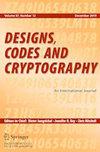对称和子空间 2 设计的可加性
IF 1.4
2区 数学
Q3 COMPUTER SCIENCE, THEORY & METHODS
引用次数: 0
摘要
如果可以将一个 2-((v,k,\lambda )\)设计嵌入到一个合适的无方群 G 中,使得其块集包含在(或重合于)其点集的所有零和 k 子集的集合中,那么这个设计就是可加的(或强可加的)。本文给出了对称设计和子空间 2 设计的可加性或强可加性的明确结果。特别是,PG(_d(n,q)\)的强可加性总是成立的,而已知的可加性只适用于\(q=2\)或\(d=n-1\)。本文章由计算机程序翻译,如有差异,请以英文原文为准。
Additivity of symmetric and subspace 2-designs
A 2-\((v,k,\lambda )\) design is additive (or strongly additive) if it is possible to embed it in a suitable abelian group G in such a way that its block set is contained in (or coincides with) the set of all zero-sum k-subsets of its point set. Explicit results on the additivity or strong additivity of symmetric designs and subspace 2-designs are presented. In particular, the strong additivity of PG\(_d(n,q)\), which was known to be additive only for \(q=2\) or \(d=n-1\), is always established.
求助全文
通过发布文献求助,成功后即可免费获取论文全文。
去求助
来源期刊

Designs, Codes and Cryptography
工程技术-计算机:理论方法
CiteScore
2.80
自引率
12.50%
发文量
157
审稿时长
16.5 months
期刊介绍:
Designs, Codes and Cryptography is an archival peer-reviewed technical journal publishing original research papers in the designated areas. There is a great deal of activity in design theory, coding theory and cryptography, including a substantial amount of research which brings together more than one of the subjects. While many journals exist for each of the individual areas, few encourage the interaction of the disciplines.
The journal was founded to meet the needs of mathematicians, engineers and computer scientists working in these areas, whose interests extend beyond the bounds of any one of the individual disciplines. The journal provides a forum for high quality research in its three areas, with papers touching more than one of the areas especially welcome.
The journal also considers high quality submissions in the closely related areas of finite fields and finite geometries, which provide important tools for both the construction and the actual application of designs, codes and cryptographic systems. In particular, it includes (mostly theoretical) papers on computational aspects of finite fields. It also considers topics in sequence design, which frequently admit equivalent formulations in the journal’s main areas.
Designs, Codes and Cryptography is mathematically oriented, emphasizing the algebraic and geometric aspects of the areas it covers. The journal considers high quality papers of both a theoretical and a practical nature, provided they contain a substantial amount of mathematics.
 求助内容:
求助内容: 应助结果提醒方式:
应助结果提醒方式:


